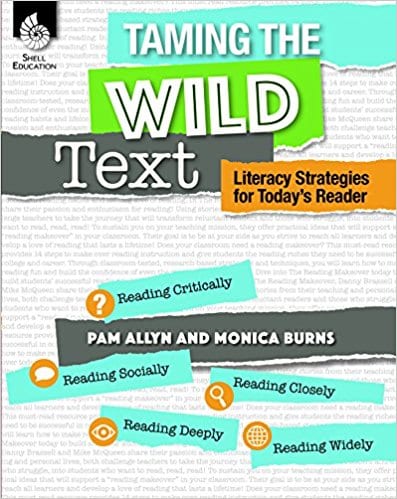Table of Contents
Literacy strategies for today’s readers Hear more from Dr. Monica Burns and other innovative analysts, thought leaders, and educators at the 2018 Future of Education Technology Conference (FETC), January 23-26 in Orlando, Florida. Learn more here.
by Dr. Monica Burns
What does reading look like for students in today’s classroom? How can we find the balance between print and digital reading materials and support students as readers? In this excerpt from Taming the Wild Text: Literacy Strategies for Today’s Readers, FETC featured speaker Dr. Monica Burns and her co-author Pam Allyn share strategies for educators navigating the world of digital and print text.
Why Reading Feels Different Now
 It is a new era for reading. Though the child in bed with a flashlight may seem like a quaint image from the past, the idea of illuminated reading under the covers can be as true today as it was yesterday. Today’s child can become immersed in the world of reading, but the light of the story glowing in the late corners of the evening may come from a screen rather than a flashlight. The reader of today is reading but not always one book at a time. This reader is athletic: jumping from idea to idea, genre to genre. He or she is reading across many platforms, many types of text, from visual to print, from moving images to primary source photographs. However, the child with the flashlight is still within us and within our children. The print book is not gone, and the technology has not taken over. Rather, the world is becoming a truly blended one. Reading is a lasting innovation in many forms. It sustains us, guides us, and makes us whole.
It is a new era for reading. Though the child in bed with a flashlight may seem like a quaint image from the past, the idea of illuminated reading under the covers can be as true today as it was yesterday. Today’s child can become immersed in the world of reading, but the light of the story glowing in the late corners of the evening may come from a screen rather than a flashlight. The reader of today is reading but not always one book at a time. This reader is athletic: jumping from idea to idea, genre to genre. He or she is reading across many platforms, many types of text, from visual to print, from moving images to primary source photographs. However, the child with the flashlight is still within us and within our children. The print book is not gone, and the technology has not taken over. Rather, the world is becoming a truly blended one. Reading is a lasting innovation in many forms. It sustains us, guides us, and makes us whole.
Many books have proposed that reading on paper is out of style, that adults are the “digital immigrants” and students are the “digital natives,” that teachers and parents have to catch up to them, and that the only way kids will keep reading is if they are flooded with tablets and other technologies in classrooms.
But just when many thought the end of print was near, in 2016, sales of children’s books exceeded sales of adult books. Overall, sales of print books are climbing, and new independent bookstores are opening at a relatively steady clip. The American Booksellers Association (ABA) reported that 60 independent bookstores opened in 31 states and the District of Columbia in 2015, besting 2016’s total by one. And so, in the midst of the new era, readers are becoming more comfortable using many platforms, and students are growing up in a world that will have more options than ever. So it is not an “either/or” world of reading; it is a world of open possibility for countless kinds of reading to exist for children. Teachers and parents must strive to develop children who can tame the wild text anywhere, in any form.
What Readers Need
 Reading has become wilder than ever. The world now is full of many types of text emerging through new technologies. Grammar is changing; devices are changing—even fonts are changing and evolving. It is a very exciting time to be a reader. But a reader’s needs, like that child under the covers with the flashlight, don’t change that much. All readers need a choice in the text that they read, access to a wide variety of texts, time to read and mentor readers who guide and inspire them. Readers need an environment in which it feels safe to take risks, where they receive affirmative feedback regarding reading progress, the opportunity to have an ever-changing identity as a reader, and a community of supportive and encouraging fellow readers.
Reading has become wilder than ever. The world now is full of many types of text emerging through new technologies. Grammar is changing; devices are changing—even fonts are changing and evolving. It is a very exciting time to be a reader. But a reader’s needs, like that child under the covers with the flashlight, don’t change that much. All readers need a choice in the text that they read, access to a wide variety of texts, time to read and mentor readers who guide and inspire them. Readers need an environment in which it feels safe to take risks, where they receive affirmative feedback regarding reading progress, the opportunity to have an ever-changing identity as a reader, and a community of supportive and encouraging fellow readers.
There are key ways in which teachers can tame the wildness of all the texts children are reading. By providing structures and strategies that support the growing reader, teachers can launch their students into the world of 21st-century reading. Today’s readers must explore text on every platform and in every genre, to struggle with text, to break through to new ideas when reading text, and to become the kind of fearless reader who tames the wild text.
Dr. Monica Burns will be a featured presenter at the 2018 FETC conference


Author
 Dr. Monica Burns is a former classroom teacher, author and the founder of ClassTechTips.com. She visits schools across the country to support PreK-20 teachers to make technology integration meaningful and sustainable in their classrooms.
Dr. Monica Burns is a former classroom teacher, author and the founder of ClassTechTips.com. She visits schools across the country to support PreK-20 teachers to make technology integration meaningful and sustainable in their classrooms.
Follow Dr. Monica Burns on Twitter.

Further Reading
- LA Times – California isn’t doing enough to teach kids how to read, lawsuit says
- CNN – How to get your kid to be a fanatic reader
- BBC – Northern Ireland and England schools in global top 10 for reading


